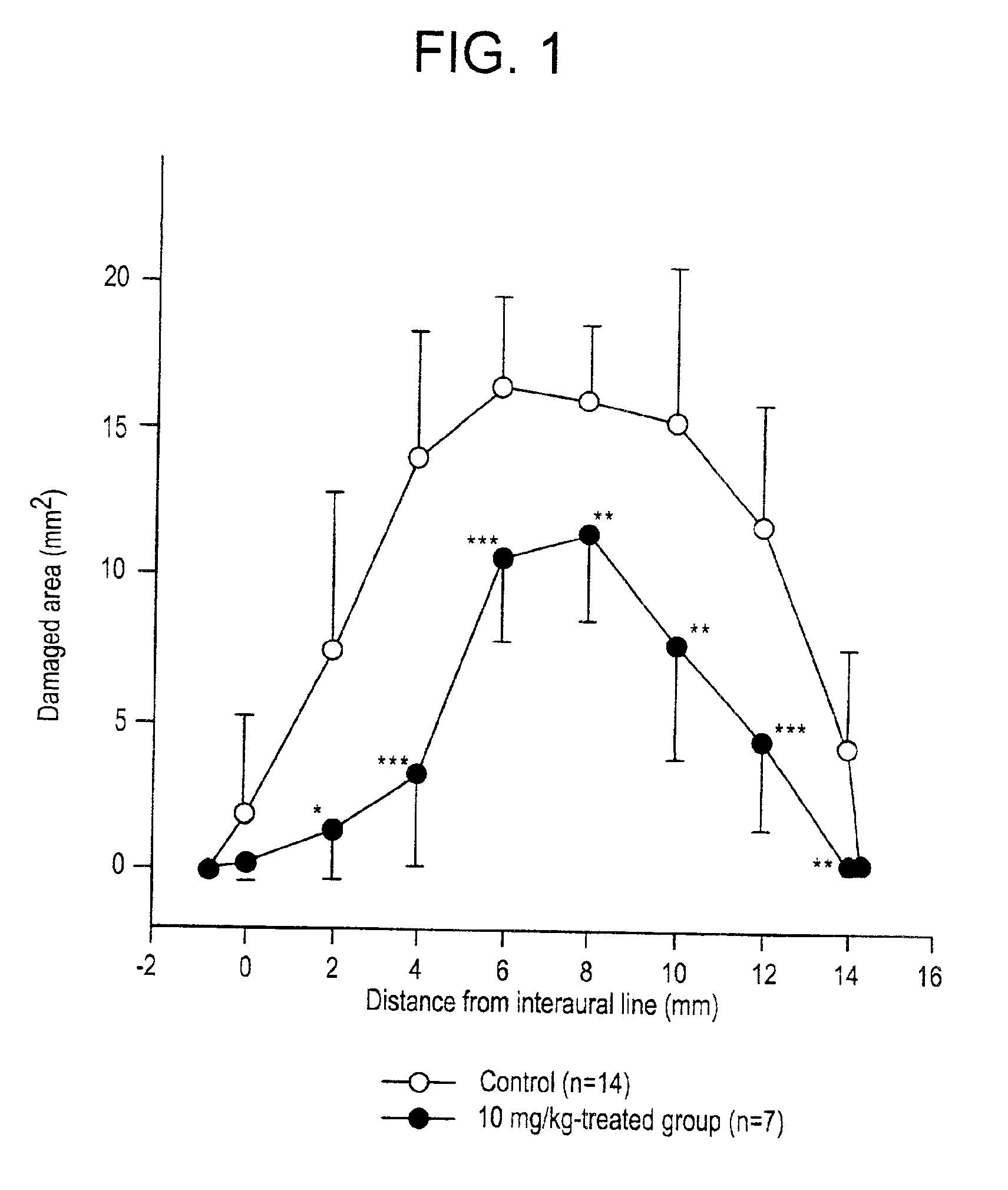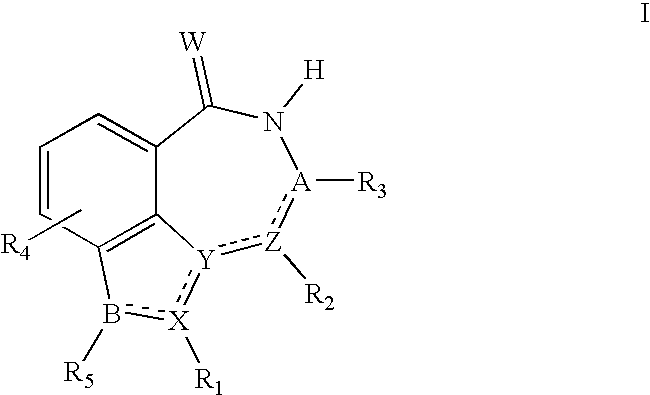[0002]The present invention relates to inhibitors of the nuclear
enzyme poly(
adenosine 5′-diphospho-ribose)
polymerase [“poly(ADP-ribose) polymerase” or “PARP”, which is also referred to as ADPRT (NAD:
protein (ADP-ribosyl
transferase polymersing)) and PARS (poly(ADP-ribose) synthetase) and provides compounds and compositions containing the disclosed compounds. Moreover, the present invention provides methods of using the disclosed PARP inhibitors to prevent and / or treat
tissue damage resulting from
cell damage or death due to
necrosis or
apoptosis;
neural tissue damage resulting from, for example,
ischemia and
reperfusion injury, such as cerebral
ischemic stroke,
head trauma or
spinal cord injury; neurological disorders and neurodegenerative diseases, such as, for example, Parkinson's or Alzheimer's diseases and
multiple sclerosis; to prevent or treat vascular
stroke; to treat or prevent cardiovascular disorders, such as, for example,
myocardial infarction; to treat other conditions and / or disorders such as, for example, age-related muscular degeneration, AIDS and other immune
senescence diseases,
inflammation,
arthritis,
gout, atherosclerosis,
cachexia,
cancer, degenerative diseases of
skeletal muscle involving replicative
senescence, diabetes (such as
diabetes mellitus), inflammatory bowel disorders (such as
colitis and Crohn's
disease),
acute pancreatitis,
mucositis,
hemorrhagic shock, splanchnic
artery occlusion shock, multiple organ failure (such as involving any of the
kidney, liver, renal, pulmonary,
retinal, pancreatic and / or
skeletal muscle systems), acute autoimmune
thyroiditis,
muscular dystrophy,
osteoarthritis,
osteoporosis, chronic and
acute pain (such as
neuropathic pain), renal failure,
retinal ischemia,
septic shock (such as
endotoxic shock), local and / or remote endothelial cell dysfunction (such are recognized by endo-dependent relaxant responses and up-regulation of adhesion molecules),
inflammation and
skin aging; to extend the lifespan and
proliferative capacity of cells, such as, for example, as general mediators in the generation of oxidants, proinflammatory mediators and / or cytokines, and general mediators of leukocyte infiltration,
calcium ion overload,
phospholipid peroxidation, impaired
nitric oxide metabolism and / or reduced
ATP production; to alter
gene expression of senescent cells; or to radiosensitize
hypoxic tumor cells.
[0004]Extensive PARP activation leads to severe depletion of NAD in cells suffering from massive
DNA damage. The
short life of poly(ADP-ribose) (half-life <1 min) results in a rapid turnover rate. Once poly(ADP-ribose) is formed, it is quickly degraded by the
constitutively active poly(ADP-ribose) glycohydrolase (PARG), together with
phosphodiesterase and (ADP-ribose)
protein lyase. PARP and PARG form a cycle that converts a large amount of NAD to ADP-ribose. In less than an hour, over-stimulation of PARP can cause a drop of NAD and ATP to less than 20% of the
normal level. Such a
scenario is especially detrimental during ischaemia when deprivation of
oxygen has already drastically compromised
cellular energy output. Subsequent free radical production during reperfusion is assumed to be a major cause of tissue damage. Part of the ATP drop, which is typical in many organs during ischaemia and reperfusion, could be linked to NAD depletion due to poly(ADP-ribose) turnover. Thus, PARP or PARG inhibition is expected to preserve the
cellular energy level to potentiate the survival of ischaemic tissues after insult.
[0013]Evidence also exists that PARP inhibitors are useful for treating inflammatory bowel disorders, such as
colitis. Salzman et al., “Role of
Peroxynitrite and Poly(ADP-
Ribose)Synthase Activation Experimental
Colitis,” Japanese J. Pharm., 75, Supp. I:15 (1997). Specifically,
Colitis was induced in rats by intraluminal administration of the
hapten trinitrobenzene
sulfonic acid in 50%
ethanol. Treated rats received 3-aminobenzamide, a specific inhibitor of PARP activity. Inhibition of PARP activity reduced the
inflammatory response and restored the morphology and the energetic status of the distal colon. See also, Southan et al., “Spontaneous Rearrangement of Aminoalkylithioureas into Mercaptoalkylguanidines, a Novel Class of
Nitric Oxide Synthase Inhibitors with Selectivity Towards the Inducible Isoform”, Br. J. Pharm., 117:619-32 (1996); and Szabó et al., “Mercaptoethylguanidine and
Guanidine Inhibitors of
Nitric Oxide Synthase React with
Peroxynitrite and Protect Against
Peroxynitrite-induced
Oxidative Damage”, J. Biol. Chem., 272:9030-36 (1997).
[0017]PARP inhibitors have been used to treat
cancer. Suto et al., “Dihydroisoquinolinones: The Design and Synthesis of a New Series of Potent Inhibitors of Poly(ADP-
Ribose)
Polymerase”,
Anticancer Drug Des., 7:107-17 (1991). In addition, Suto et al., U.S. Pat. No. 5,177,075, discusses several isoquinolines used for enhancing the lethal effects of
ionizing radiation or chemotherapeutic agents on
tumor cells. Weltin et al., “Effect of 6(5H)-Phenanthridinone, an Inhibitor of Poly(ADP-ribose)
Polymerase, on Cultured
Tumor Cells”, Oncol. Res., 6:9, 399-403 (1994), discusses the inhibition of PARP activity, reduced proliferation of
tumor cells, and a marked synergistic effect when
tumor cells are co-treated with an alkylating
drug.
[0023]There continues to be a need for effective and potent PARP inhibitors which produce minimal side-effects. The present invention provides compounds, compositions for, and methods of, inhibiting PARP activity for treating and / or preventing cellular, tissue and / or
organ damage resulting from
cell damage or death due to, for example,
necrosis or
apoptosis. The compounds and compositions of the present invention are specifically useful in ameliorating, treating and / or preventing neural tissue or
cell damage, including that following focal ischemia and
reperfusion injury. Generally, inhibition of PARP activity spares the cell from
energy loss, preventing irreversible
depolarization of the neurons and, thus, provides
neuroprotection. While not wishing to be bound by any mechanistic theory, the inhibition of PARP activity by use of the compounds, compositions and methods of the present invention is believed to protect cells, tissue and organs by protection against the ill-effects of reactive free radicals and
nitric oxide. The present invention therefore also provides methods of treating and / or preventing cells, tissue and / or organs from reactive free radical and / or
nitric oxide induced damage or injury.SUMMARY OF THE INVENTION
 Login to View More
Login to View More  Login to View More
Login to View More 


